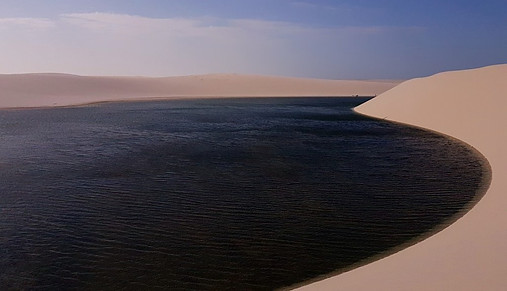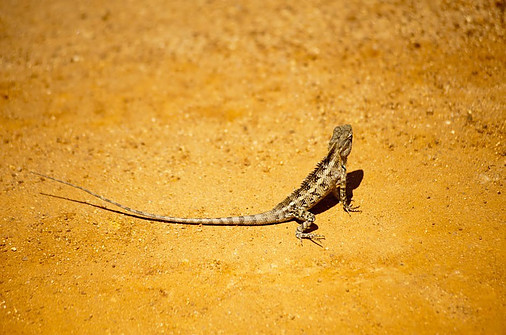
Water
In desert situations, water is of paramount importance. Finding it is VITAL. If you have it, begin rationing it immediately. If you are stranded by a mechanical failure on a planned desert crossing, the locations of oases, wells and waterholes would (or should) have been previously plotted along your route. In these locations, wells will be very deep and therefore will require a container on a line to retrieve the water. Smaller watering holes in wadi bottoms are often seasonal and are usually covered with a stone or brushwood.
Away from known waterholes, your best bet is digging at the lowest point of the outside bend of a dry stream bed or at the lowest point between dunes. Regardless of where you search DO NOT dig in the heat of the day. The exertion will cause you to lose vital fluids and you may find one to replace it. You must always balance fluid loss against possible gain.
Instead, exploit cactus and roots as water sources. In deserts where the day/night temperature is great, exploit this difference to collect water from condensation.
Life Expectancy
Life expectancy in the desert depends on two things:
- The available water
- The ability to protect the body from sun exposure to reduce perspiration
In this situation you can allow for a negative fluid balance. Drink 2½ pints (1.5 liters) for every 3½ pints (2 liters) lost and then drink at the rate that the body is sweating. Efficiency is then impaired little and no water is wasted. Less fluid will not result in less sweating. Sweating is a cooling mechanism and is dependent on the ambient temperature. It is not a way of losing moisture. If more fluid is available than is necessary, it will be excreted and serve no purpose.
OK – now for the important information. Without water, you will last about 2½ days at 118° F (48° C) – if you spend the entire time resting in the shade. However, you could last as long as 12 days if the temperature stays below 70° F (21° C).
If you are forced to walk to safety, the amount of distance you will be able to cover will depend directly on the amount of available water.
With none, a temperature of 118° F (48° C), walking only at night, resting all day, you can cover about 25 miles (40 km). Attempting to walk by day, you would be lucky to complete 5 miles (8 km) before you collapse.
With 3½ pints (2 liters) of water, a temperature of 118° F (48° C), attempting to walk by day, you might cover about 35 miles (56 km) and last about 3 days.
Your chances are not appreciably increased until the available water reaches about 8 pints (4½ liters) per person, though training and a determination to survive could contradict these predictions.
Food
Heat usually causes a loss or appetite, so don’t force yourself to eat. I’m a living example of this, my appetite falls through the floor during the summer, picks up in the fall and becomes full-blown during winter. In any case, if you find yourself in this situation, don’t force yourself to eat.
Remember that protein foods increase metabolic heat and increase water loss, and liquids are needed for digestion. So, if water is scarce, keep eating to a minimum and only then try to eat moisture-containing foods, such as fruit and vegetables.
Foods spoil very quickly and easily in the desert and any stores, once opened should be eaten immediately or kept covered and shaded. Flies will appear from nowhere and settle on any uncovered food.
Plants
Away from oases and waterholes, vegetation is likely to be little more than scrubs and grasses, even in the semi-desert areas. However, grass is edible and sometime plentiful. As someone who has eaten both grass and leaves, I can attest to this. Remember that some foods we already eat, like lettuce and spinach, are technically leaves. In this environment, the Acacia tree provides edible beans. However, beware of the tree’s thorns, even though all the soft parts: flowers, fruit, seeds bark and young shoots are safe to touch and eat.
The grasses of the Sahara and Gobi deserts are neither nutritious nor palatable. However, either of these deserts you may find the Desert Gourd, a member of the squash family. Its vine can run over the ground for 15ft (4.5m). You can chew its water-filled shoots and eat its flowers and orange-sized fruits. Also, the seeds are edible whether they roasted or boiled.
In the Mexican desert, the Mescal plant (an agave, from which tequila is made) grows with a rosette of thick, tough, sharp-tipped leaves. Its central stalk, which rises like a candle to a flowering head, can be eaten. Cut the ends off the leaves and suck out the water.
Animals
Deserts often support different varieties of hardy animals that can either burrow into sand or hide in any available shade during the day. These include: insects, reptiles, small rodents, and specially adapted mammals such s the Fennec Fox of North Africa, the Austrailian Bandicoot, the Gobi Hedgehog and the North American Jack-Rabbit. All the creatures have large ears to assist in cooling. If you happen to see any large mammals, it’s a good indication that water is somewhere nearby.
Also, the Sahara desert has gerbils and gerboas; the Middle East has caracals and hyenas; the New World, kangaroo-rats and coyotes.

Health
Most desert illnesses are caused by excessive exposure to sun and heat and a subsequent loss of fluids. This can be avoided or at least mitigated by keeping the head and body covered and remaining in the shade until sundown.
As a reminder:
- Constipation and pain in passing urine are common and salt-deficiency can lead to cramps
- Continued heavy sweating on the skin, coupled with the rubbing caused by clothing can produce sweat gland blockages and an uncomfortable skin irritation known as “prickly heat”. I have experienced this and while not debilitating, it is extremely irritating.
- Heat cramps, which eventually lead to heat exhaustion, heat stroke and serious sunburn are all dangers. A gradual increase in activity and daily exposure will eventually lead to an increase in tolerance, provided an adequate supply of water is available.
- Even in the desert, where one would think life is rare, various micro-organisms will attack the moist areas of the skin. The crevices of the armpits, the groin and the area between the toes are all susceptible. By keeping these areas clean and dry, you can prevent these little buggers from getting a foothold.
